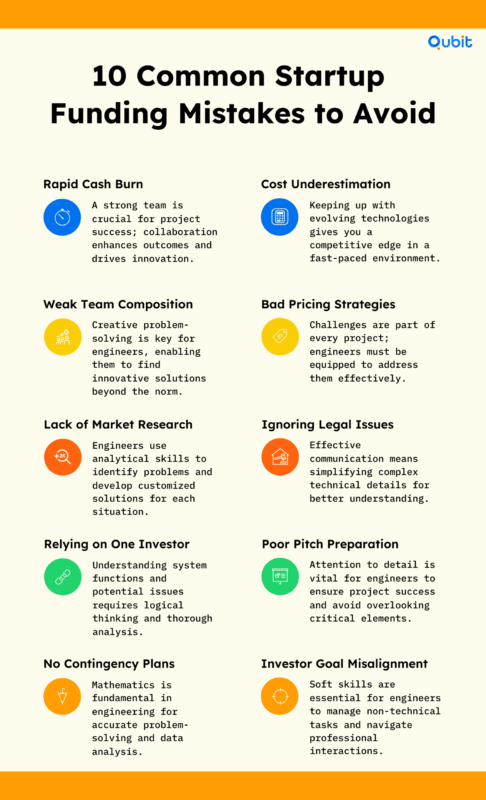Securing funding is a critical milestone for startups, yet many founders stumble due to avoidable errors. From misjudging investor expectations to overlooking essential preparation, these startup mistakes can derail even the most promising ventures. This blog dives into expert insights to help entrepreneurs sidestep common funding pitfalls and position their businesses for success.
Understanding the core principles of startup fundraising strategies can significantly reduce the likelihood of common funding mistakes. By mastering the fundraising process and recognizing operational errors, founders can make informed decisions that enhance their chances of securing capital.
This article will explore actionable strategies to avoid mistakes, eligibility criteria for funding, and key operational considerations. Whether you're a first-time founder or a seasoned entrepreneur, these insights will provide the clarity needed to navigate the complexities of startup funding effectively.
Comprehensive Guide to the Top Funding Mistakes
Securing funding is a critical milestone for startups, but many founders stumble over avoidable errors that can derail their progress. This guide highlights the top 10 funding mistakes, offering actionable solutions to help startups sidestep these pitfalls and build a solid financial foundation.

1. Rapid Cash Burn
Poor cash flow management is the leading cause of startup failure, contributing to 82% of closures. Founders often overspend on non-essential areas, leaving little room for operational flexibility. To remedy this, implement efficient cash management systems and prioritize disciplined financial oversight.
2. Cost Underestimation
About 53% of startups miscalculate the funds required for their first year, leading to funding shortfalls. Accurate budgeting is essential, and incorporating tools like financial planning workshops can help founders stress-test their expense estimates. Learn more about startup costs.
3. Weak Team Composition
A mismatched or underqualified team can hinder growth and investor confidence. Structured delegation and hiring individuals with complementary skills are vital steps to avoid this mistake.
4. Improper Pricing Strategies
Pricing products or services too high or too low can alienate customers and erode profitability. Conducting thorough market research ensures pricing aligns with customer expectations and competitive benchmarks.
5. Lack of Market Research
Failing to understand the target audience and industry trends can lead to misguided decisions. Comprehensive market research provides insights that guide product development and marketing strategies.
6. Ignoring Legal Compliance
Overlooking formal agreements and legal safeguards can jeopardize funding security. Addressing legal compliance for startups ensures operational stability and protects business interests.
7. Overdependence on a Single Investor
Relying heavily on one funding source increases vulnerability. Diversifying funding streams, such as venture capital, angel investors, and crowdfunding, mitigates risk.
8. Poor Pitch Preparation
A weak pitch presentation can deter potential investors. Founders should focus on crafting compelling narratives backed by data-driven insights to secure funding effectively.
9. Neglecting Contingency Planning
Failing to prepare for unforeseen challenges can result in financial instability. Establishing contingency plans ensures startups can adapt to unexpected circumstances without compromising growth.
10. Misaligned Goals with Investors
Miscommunication or conflicting objectives between founders and investors can lead to strained relationships. Clear communication and alignment of goals are crucial for long-term collaboration.
Avoiding these common small business mistakes requires proactive planning and structured execution. By addressing these issues early, startups can enhance their funding prospects and build a sustainable future.
The Fundraising Process: A Step-by-Step Blueprint
Securing funding is one of the most pivotal challenges for startups, but breaking the process into clear stages can make it more manageable. Each step in the fundraising journey, from preparation to closing negotiations, plays a critical role in avoiding common mistakes and ensuring success.
1. Preparation: Setting the Foundation
The first step in fundraising is thorough preparation. Startups must define their funding goals, determine how much capital they need, and identify the right type of investors to approach. A well-crafted pitch deck, backed by financial projections and a clear business model, is essential. This stage is also an opportunity to address potential startup issues, such as unclear governance structures, which can deter investors. Strong corporate governance in startups ensures transparency and builds trust, essential for avoiding funding-related mistakes.
2. Investor Outreach: Building Relationships
Once the groundwork is laid, the next step is reaching out to potential investors. Tailor your communication to each investor’s interests and portfolio focus. Personalized outreach demonstrates that you’ve done your research and increases the likelihood of engagement. During this stage, startups should anticipate common questions and prepare detailed answers to showcase their expertise and vision.
3. Due Diligence: Proving Your Value
After initial interest, investors will conduct due diligence to assess the viability of your business. This process involves reviewing financials, legal documents, and operational details. Transparency is key here—any discrepancies can erode investor confidence. Addressing potential startup issues early on can help streamline this stage and prevent delays.
4. Negotiating Term Sheets: Securing Favorable Terms
The final step in the fundraising process is negotiating the term sheet. This document outlines the terms and conditions of the investment, including valuation, equity distribution, and investor rights. Effective negotiation requires a balance between securing favorable terms and maintaining a collaborative relationship with investors.
By following these steps, startups can optimize their fundraising efforts and mitigate common pitfalls. Whether it’s preparing a compelling pitch or negotiating terms, each stage builds toward securing the capital needed to grow and thrive.
For more insights on building investor trust, explore how corporate governance in startups can enhance transparency and credibility. Corporate governance ensures transparency and builds trust, essential for avoiding funding-related mistakes.
Avoiding Eligibility Pitfalls: What VCs Really Expect
Securing venture capital funding requires more than just a compelling idea. Venture capitalists (VCs) evaluate startups based on stringent eligibility criteria, focusing on risk-reward ratios and strategic alignment. These criteria often center on the scalability of your business model, market potential, and the team’s ability to execute. Failing to meet these benchmarks is one of the most common startup mistakes, as it can derail funding opportunities before they even begin.
Early-stage founders often underestimate the value of informal interactions with VCs, such as coffee meetings. These casual conversations serve as a low-pressure environment to test your pitch and gain invaluable feedback. They also help build rapport with investors, laying the groundwork for future discussions. For example, a VC might point out gaps in your market research or suggest refining your revenue projections, giving you actionable insights to strengthen your proposal.
Building strong relationships with VCs doesn’t stop at eligibility. Maintaining strong investor relations after funding helps founders secure future rounds and navigate financial hurdles. This ongoing connection ensures your business remains aligned with investor expectations, fostering trust and long-term collaboration.
Avoiding business mistakes like overlooking eligibility criteria or skipping informal feedback sessions can significantly improve your chances of securing funding. By understanding what VCs truly expect, founders can better position their startups for success.
Beware of Overasking: Secure Funding in Phases
Securing excessive funds early in a startup’s journey may seem advantageous, but it often leads to unintended consequences. Common small business mistakes, such as resource misallocation and unsustainable burn rates, can arise when funding exceeds immediate needs. Overasking for capital can push startups into premature scaling, resulting in inefficiencies that hinder long-term growth.
An iterative funding approach offers a more sustainable alternative. By aligning capital intake with validated business milestones, startups can maintain focus and avoid unnecessary dilution. This strategy ensures that each funding round is tied to measurable progress, reducing the risk of overextending resources.
Additionally, overfunding often leads to premature expansion, which can create operational challenges. For insights on managing growth post-fundraising, explore strategies for scaling startup after fundraising. This approach emphasizes balancing growth with sustainability, ensuring that startups remain agile and adaptable.
By adopting a phased funding strategy, entrepreneurs can avoid common startup issues and focus on building a strong foundation for success.
Strategies for Sustainable Growth: Avoid Early Errors
Startups often stumble in their early stages due to critical missteps, particularly in funding and planning. Recognizing these problems with startups early on can prevent long-term setbacks. For instance, overestimating funding needs or misallocating resources can drain capital before the business gains traction. Addressing these errors promptly ensures that financial stability is maintained as the company scales.
An equally important fundraising best practice for startups is adapting to customer feedback. Businesses that actively listen to their audience can refine their offerings and align with market demands. Proactive adjustments, such as streamlining operations or enhancing product features, not only improve customer satisfaction but also build a foundation for sustainable growth.
Mistakes to avoid include ignoring operational inefficiencies or delaying corrective actions. A well-thought-out strategy, combined with a willingness to pivot when necessary, can transform early challenges into opportunities for long-term success.
Additional Insights: More Stories to Inspire Your Journey
Exploring diverse perspectives can often reveal unexpected solutions to common startup mistakes. This section introduces a collection of narratives and case studies that delve into challenges like team dynamics, product launch hurdles, and business mistakes to avoid. For example, one founder shares how miscommunication during a product rollout led to delays, highlighting the importance of clear team protocols. Another case study examines how a startup overcame funding obstacles by pivoting its business model.
These stories offer valuable lessons and actionable insights, encouraging you to reflect on your own journey. Embrace these resources to deepen your understanding and refine your strategies.
Conclusion
Securing startup funding demands meticulous preparation, strategic investor engagement, and scalable processes. By focusing on these elements, founders can position their ventures for sustainable growth. Clear and actionable financial planning plays a pivotal role in avoiding common pitfalls, ensuring that funding efforts align with long-term goals.
If you’re ready to refine your funding strategy and secure the capital you need, we at Qubit Capital are here to help. Explore our Fundraising Assistance service to get started.
Key Takeaways
- Thorough preparation and clear financial planning are critical to avoiding funding pitfalls.
- Understanding and aligning with VC eligibility criteria can make or break your funding success.
- Iterative funding strategies help prevent overasking and unsustainable burn rates.
- Building a strong team and maintaining legal and operational compliance are essential.
- Continuous adaptation and incorporating customer feedback pave the way for sustainable growth.
Frequently asked Questions
What is the #1 mistake startups can make?
Underestimating financial needs is the top mistake, as many startups fail due to poor cash flow management and inadequate budgeting. Data shows that a significant percentage of startups miscalculate their expenses.


 Back
Back



